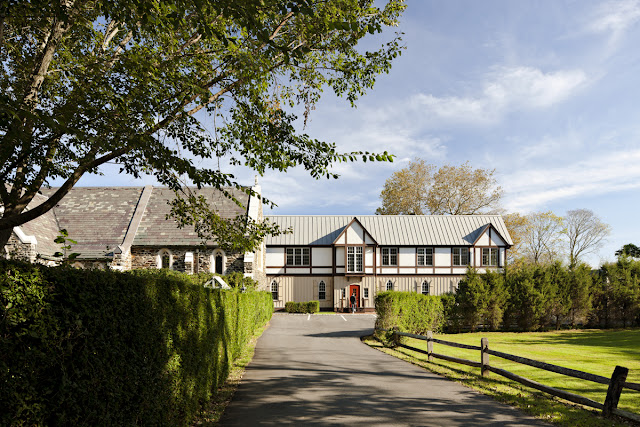Better Living in the Tropics
I grew up in San
Juan, Puerto Rico where intense heat and bright light of the tropical sun,
caressing trade wind breezes, “painted” clouds, and violent rain showers follow
each other in a continuous daily sequence.
Everything changed for me when I went to study abroad to the US, France
and Italy. It was marvelous to experience other cultures and see first-hand our
European roots, but I never forgot the intoxicating climate of my beautiful
island: Puerto Rico.
 |
Old San Juan, photo by author
|
After my
architectural schooling, I chose to stay in New York City to work for one of
most creative firms at the time, Hardy Holzman Pfeiffer. I was extremely fortunate to work on a lot of very interesting theaters, performing arts centers, libraries and museums. After 14 years, I joined Ferguson Shamamian and later Roger Ferris; offices that taught me a great deal about single-family residential design. I then joined Jaque Robertson and Edward Siegel at Jaque’s eponymous firm: Cooper
Robertson. It was with them that I learned the timeless principles for
designing houses in the tropics.
One of the first principles Jaque taught us was to ignore the prevailing trends and instead follow time proven
strategies that respond to the climate as well as the “open-air” Caribbean
lifestyle. Think about it, why would you want to spend your money chasing after
someone else’s definition of the latest trend? Why not have a house that fits
your needs, lifestyle, and budget? Everyone has a budget, it does not matter
what your financial situation is; the point is to use your resources to make
the best use of your property.
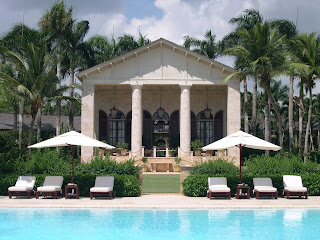 |
| La Romana, DR, photo by Steven Brooke |
 |
| La Romana, DR, photo by Steven Brooke |
The house above was
built in 2002 in La Romana, Dominican Republic and took as precedent Heron Bay,
the Palladian inspired villa designed for Ronald Tree in Barbados and built in
the late 1940’s, shown below.
 |
Heron Bay, photo from Architecture and Design in Barbados,
found in the Devoted Classicist blog by John Tackett, June 4, 2014 |
 |
Heron Bay, photo by Slim Aarons from A Place in the Sun,
found in the Devoted Classicist blog by John Tackett, June 4, 2014 |
Both houses use
the timeless language of Classical architecture in a relaxed and tropical
manner with pared-down details, robust stone columns, and a minimal palette of
materials: coral stone walls, brick and coral stone paving, mahogany windows as well as interior floors, and exterior showers with unlacquered brass fittings; the
exterior lamps are copper. These simple materials wear well in the hot and
humid tropical climate.
The light color
coral stone feels cool under your feet as Lee McLaren, socialite and friend of
the Trees, illustrates in the photo above. Being outdoors as much as possible
is one of the pleasures of living in the tropics and both houses take advantage
of that with areas to relax and enjoy the outdoors.
La Romana, DR, photo by Steven Brooke
The use of Coral stone, locally available in the Domincan
Republic, provided a durable and care-free material. Hurricane on its
way…no worries!
 |
La Romana, DR, photo by author
Curving exterior corridors present a pleasant walk from
one end of the house to the other while providing views of the ocean
through a fragrant garden and allowing access to the individual bedrooms
strung along its path. Why connect the rooms in a contained air-conditioned
environment, when you are living right on the beach?
La Romana, DR, photo by author
|
Stopping points
along the way such as the “Chinese” dining pavilion above, provide an intimate
setting for lunch in a shaded, but airy enclosure surrounded by your favorite
plants.
 |
| La Romana, DR, photo by author |
Details such as
potted plants, hanging or wall-mounted outdoor lamps, trellises, rafter tails, a
variety of paving materials and patterns within a reduced palette (Coral Stone,
brick, and grass), and a variety of planting, provide visual focus and the
necessary layering to engage your senses and imagination while enjoying the
cool breezes and surrounding ocean views.
Many designers have echoed similar design principles with equally fine results in houses of modest proportions. In the 1960’s and
70’s, Oliver Messel, a British costume and stage designer who decided to move
to the Caribbean for health reasons, created a series of houses in Barbados and
Mustique that exploit their setting for the pleasure and well-being of its occupants.
 |
House in Barbados by Oliver Messel,
photo found in 'Cote de Texas' blog by Joni Webb, February 2009 |
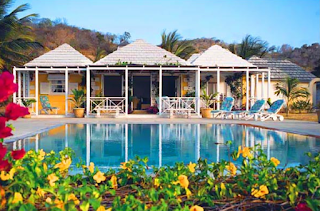 |
House in Mustique by Oliver Messel,
photo found in 'Cote de Texas' blog by Joni Webb, February 2009 |
More recently Tom
Scheerer, a NY architect and decorator, designed simple and elegant houses that
again follow timeless principles for designing in the tropics.
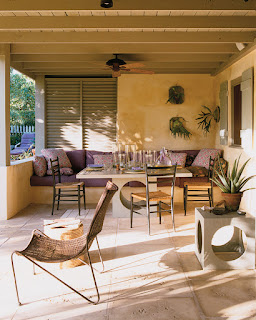 |
| Photo by Pieter Estersohn, NY Times Style Magazine, August 2013 |
 |
| Photo by Bjorn Wallender, AD April 2016 |
To summarize, the design principles are:
1- Open air living in
shaded outdoor rooms that take advantage of the warm climate and cool breezes.
 |
House in Barbados by Oliver Messel,
photo found in 'Cote de Texas' blog by Joni Webb, February 2009 |
2-
The use of
architectural elements such as porches, colonnades, covered terraces, pergolas,
and awnings.
 |
Houses above by Oliver Messel,
found in 'Cote de Texas' blog by Joni Webb, February 2009 |
3- The use of devices
that allow cross ventilation such a lattices, door transoms, and jalousie or
louvered windows.
 |
| House in the Bahamas, photo by author |
4-
High ceilings and
ceiling fans.
 |
| Photo by Bjorn Wallender, AD April 2016 |
5-
Outdoor showers.
 |
House in Barbados by Oliver Messel,
photo found in 'Cote de Texas' blog by Joni Webb, February 2009 |
6-
A simple palette of materials that are care-free in the
harsh sea salt environments (if close to the beach) such as coral stone, mahogany
or teak, encaustic cement tiles, cedar shingles, unlacquered brass plumbing
fittings, and copper lamps.
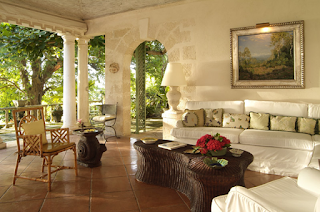 |
House in Barbados by Oliver Messel,
photo found in 'Cote de Texas' blog by Joni Webb, February 2009 |
7- The use of a
materials that breath and allow evaporation of humidity such as cotton, linen,
straw, and rattan.
 |
House in Mustique by Oliver Messel,
photo found in 'Cote de Texas' blog by Joni Webb, February 2009 |
For the past two
years, I have been working on the design for a house in the Bahamas (with
Edward Siegel, the partner-in-charge, and Ernest de la Torre, the decorator) that
incorporates these lessons.
A roofed corridor shaded
with mahogany shutters connects the first floor rooms and bedrooms. This corridor, though appearing as if it was
exterior is actually part of the air-conditioned part of the house.
Shaded first and
second floor porches provide exterior areas to enjoy views of the ocean as well
as children or adults using the pool.
The 5 photos above are construction progress photos by the builder.
Interior photos are not shown to protect the Owner's privacy.
A place to take a
shower and change are very useful after a swim in the ocean or the pool.
The last image
shows Oscar de la Renta’s ranch in the Domincan Republic. This is a simple and
dignified wood house which serves to illustrate that trendiness is not the point but
simply appropriateness.
 |
| photo by Oberto Gili, Vogue, September 1989 |




